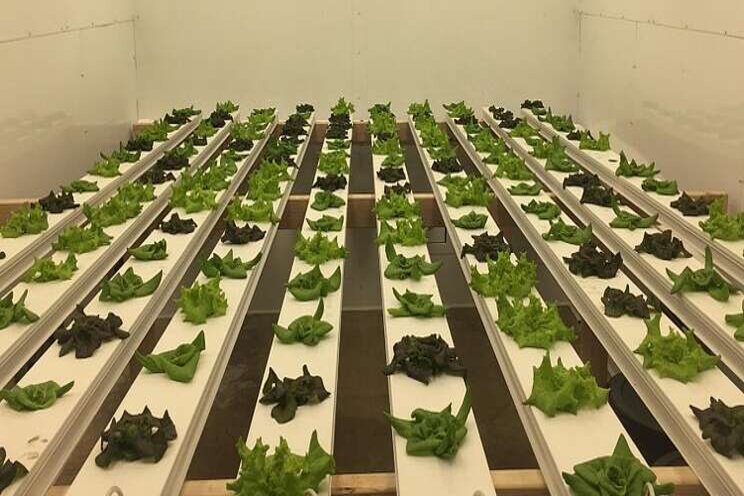Consider the photosynthetic benefits of far-red radiation
Added on 17 August 2021

Traditionally, horticultural lights were chosen based on their light output in terms of photosynthetically active radiation (PAR), that is wavelengths of light from 400 to 700 nm (i.e., visible light from blue to red). Recently, however, researchers have concluded that far-red photons are required alongside PAR for efficient photosynthesis. Far-red is also important for crop growth including leaf expansion, stem elongation, and flowering.
Considering the benefits of far-red for photosynthesis, a new term has been introduced called extended photosynthetically active radiation (EPAR; ? = 400 to 750 nm).
In recent years, high-efficacy LED fixtures have been replacing high-pressure sodium and fluorescent lamps due to their energy savings. Many of these lamps are composed of blue and red diodes, resulting in a magenta hue. These photons correspond well to the original definition of PAR and do well when used as supplemental lighting because the ambient sunlight in the greenhouse will provide a broad spectrum of light including far-red. The problem arises when propagation is separated from the greenhouse where it relies on artificial light as its sole source of photosynthetic radiation. In this situation, narrow waveband red-blue lighting may not give optimum plant photosynthesis or leaf expansion.
Research conducted by the USDA-LAMP Project (Lighting Approaches to Maximize Profits) at Cornell University has focused on the neglected photons, like far-red radiation. The objective of the research was to investigate the performance of lettuce and basil seedlings when growing in a propagation chamber with and without far-red radiation. By encouraging leaf expansion with far-red, we hypothesized that once transplanted the seedlings would capture more light ultimately leading to a larger harvested size.
EXPERIMENT ONE: LETTUCE
The first experiment was performed in a growth chamber with three cultivars of lettuce: 'Rex', 'Salanova Red Oak' and 'Grand Rapids'. Seedlings were germinated in rockwool for two days in perforated 1020 flats with humidity domes. After the initial germination, plants were exposed to white LED light (delivering a light intensity of 195 ?molˇm-2ˇs-1) supplemented with far-red radiation (delivering a light intensity of 5, 10, 20, or 30 ?molˇm-2ˇs-1) for 20 hours daily for 10 days (Figure 1). Chamber temperatures were set to 75ş F during the day and 66ş F at night.
At 12 days after seeding, lettuce plants with 30 ?molˇm-2ˇs-1 of supplemental far-red intensity had fresh weights that were 32% greater than plants exposed to only 5 ?molˇm-2ˇs-1 of far-red (Figure 2). Leaf area was also increased by 38% for plants receiving 30 ?molˇm-2ˇs-1. Plants that were exposed to greater intensities of supplemental far-red radiation were larger and growing faster than those with less in all cultivars examined.
EXPERIMENT TWO: BASIL
The second experiment evaluated basil seedling cultivars ('Genovese', 'Prospera' and 'Spicy Bush'). This experiment was set up similar to the first with one exception; a duration component to the supplemental far-red radiation was incorporated. Basil seeds were germinated for two days as described previously in lettuce.
After germination, all seedlings were exposed to the same lighting treatments (white LED delivering a light intensity of 195 ?molˇm-2ˇs-1 + 5, 10, 20, or 30 ?molˇm-2ˇs-1 far-red radiation for 20 h-1ˇd-1). This time, basil seedlings were exposed to these lighting treatments for 10 days or only the first five days (at which point they would only receive 5 ?molˇm-2ˇs-1 far-red for another five days). Growth chamber daytime temperatures were set at 80ş F and 75ş F at night.
At 12 days after seeding, basil seedlings were evaluated for growth parameters. Fresh weight for seedlings that received 30 ?molˇm-2ˇs-1 of supplemental far-red radiation for five days were 25% greater than those that only received 5 ?molˇm-2ˇs-1 far-red (Figure 3). Furthermore, seedlings that received 30 ?molˇm-2ˇs-1 far-red for 10 days had a 54% greater fresh weight than 5 ?molˇm-2ˇs-1 far-red. Additionally, leaf area was increased 19 and 41% for seedlings exposed to five and 10 days of 30 ?molˇm-2ˇs-1 far-red, respectively when compared to basil seedlings receiving 5 ?molˇm-2ˇs-1 of far-red radiation.
RESULTS
In both experiments, plants that were given a greater intensity of far-red radiation produced larger seedlings. All of these seedlings were transplanted into a hydroponic NFT system (Figure 4) to grow to a mature size (37 days after seeding). Maturation occurred in a growth chamber under white LED lights (delivering a light intensity of 295 ?molˇm-2ˇs-1 of PAR + 5 ?molˇm-2ˇs-1 of far-red radiation) with a photoperiod of 16 hours. Fresh weight and other parameters were no longer significantly different for mature lettuce heads at different treatment levels.
We believe that the white LED lights in the NFT finishing environment did not provide enough far-red radiation for the lettuce plants to sustain their accelerated growth revealed at the transplant stage. However, basil plants (especially those with 20 or 30 ?molˇm-2ˇs-1 far-red for 10 days) were significantly larger (18 to 23% increase in fresh weight) than plants that had received 5 ?molˇm-2ˇs-1 at the seedling stage. Thus, if you are starting basil in a seedling chamber it may make sense to choose a light source that includes a far-red component. A greenhouse environment under ambient sunlight likely provides the necessary far-red radiation. More research is needed to determine if there are beneficial responses to far-red for seedlings grown in a greenhouse.
The truth is the perfect spectrum for every plant is unknown and will remain that way for the foreseeable future. However, we do know that far-red radiation is necessary for highly efficient photosynthesis. New LED lamps are not cheap, and every grower would like to see a good return on investment for lamps purchased that encompasses energy savings and yield increases. This article will not tell you specifically which lamps to buy, but it provides evidence that far-red is important for sole-source lighting. Be sure to talk to the lighting manufacturer about the spectral distributions of the fixtures you are interested in.
Source and Photo courtesy of Greenhouse Product News
Source: Greenhouse Product News
More news















